Analyzing Sainsbury's Marketing Strategies: A Detailed Report
VerifiedAdded on 2023/01/07
|11
|3910
|98
Report
AI Summary
This report provides a comprehensive analysis of Sainsbury's marketing operations, examining promotional activities across various touchpoints including customer-facing areas, external spaces, digital platforms, and third-party collaborations. The report details specific promotional strategies such as pamphlets, advertisements, and social media campaigns, highlighting their role in attracting and retaining customers. Furthermore, it applies marketing theories like AIDA to assess the effectiveness of Sainsbury's marketing tactics, providing insights into how these strategies influence customer behavior and brand perception. The analysis covers various aspects of Sainsbury's operations, including the use of billboards, digital websites, social media, and partnerships with news outlets and analyst reports. The report evaluates the impact of these marketing efforts on Sainsbury's brand value and customer acquisition, offering a detailed overview of the company's marketing landscape.

Project
Paraphrase This Document
Need a fresh take? Get an instant paraphrase of this document with our AI Paraphraser
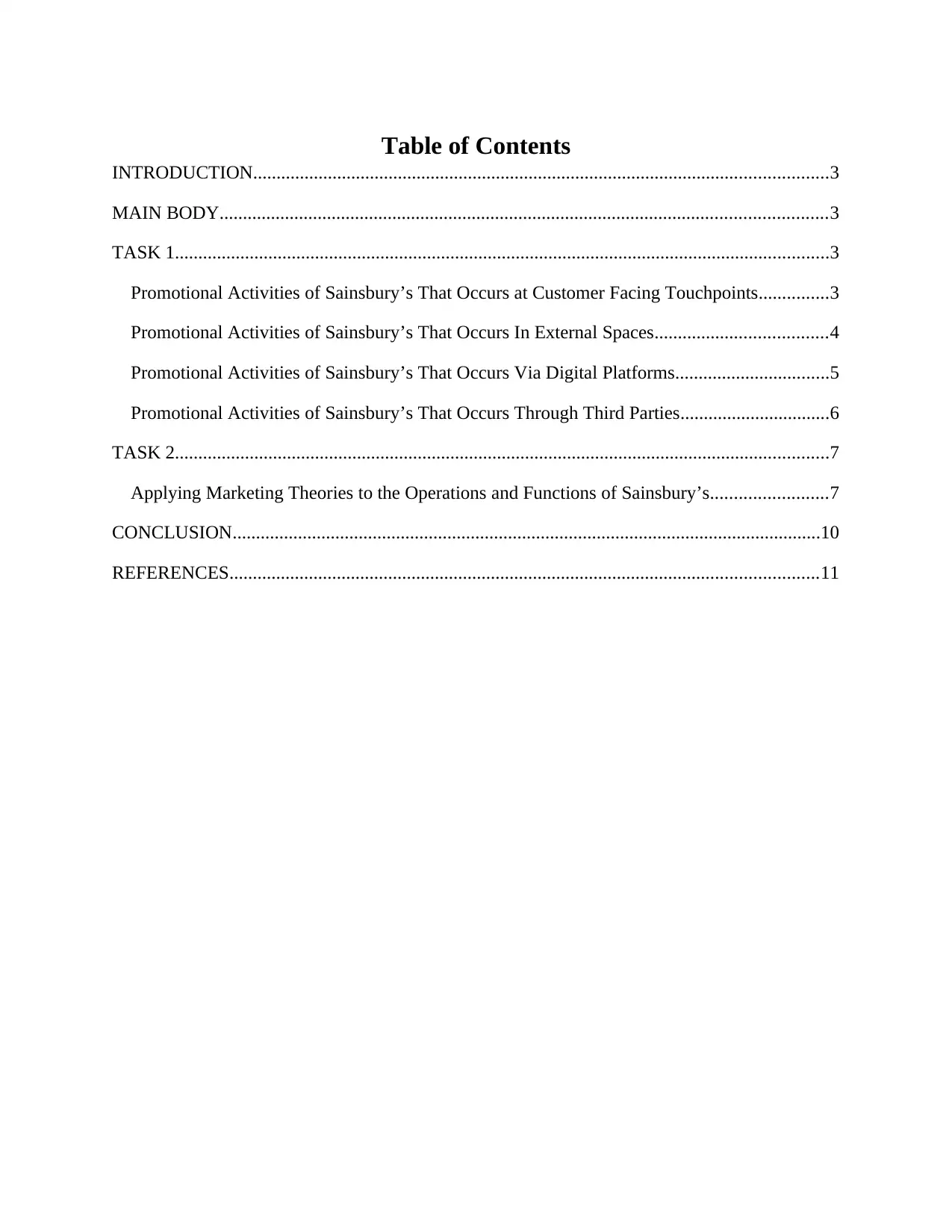
Table of Contents
INTRODUCTION...........................................................................................................................3
MAIN BODY..................................................................................................................................3
TASK 1............................................................................................................................................3
Promotional Activities of Sainsbury’s That Occurs at Customer Facing Touchpoints...............3
Promotional Activities of Sainsbury’s That Occurs In External Spaces.....................................4
Promotional Activities of Sainsbury’s That Occurs Via Digital Platforms.................................5
Promotional Activities of Sainsbury’s That Occurs Through Third Parties................................6
TASK 2............................................................................................................................................7
Applying Marketing Theories to the Operations and Functions of Sainsbury’s.........................7
CONCLUSION..............................................................................................................................10
REFERENCES..............................................................................................................................11
INTRODUCTION...........................................................................................................................3
MAIN BODY..................................................................................................................................3
TASK 1............................................................................................................................................3
Promotional Activities of Sainsbury’s That Occurs at Customer Facing Touchpoints...............3
Promotional Activities of Sainsbury’s That Occurs In External Spaces.....................................4
Promotional Activities of Sainsbury’s That Occurs Via Digital Platforms.................................5
Promotional Activities of Sainsbury’s That Occurs Through Third Parties................................6
TASK 2............................................................................................................................................7
Applying Marketing Theories to the Operations and Functions of Sainsbury’s.........................7
CONCLUSION..............................................................................................................................10
REFERENCES..............................................................................................................................11
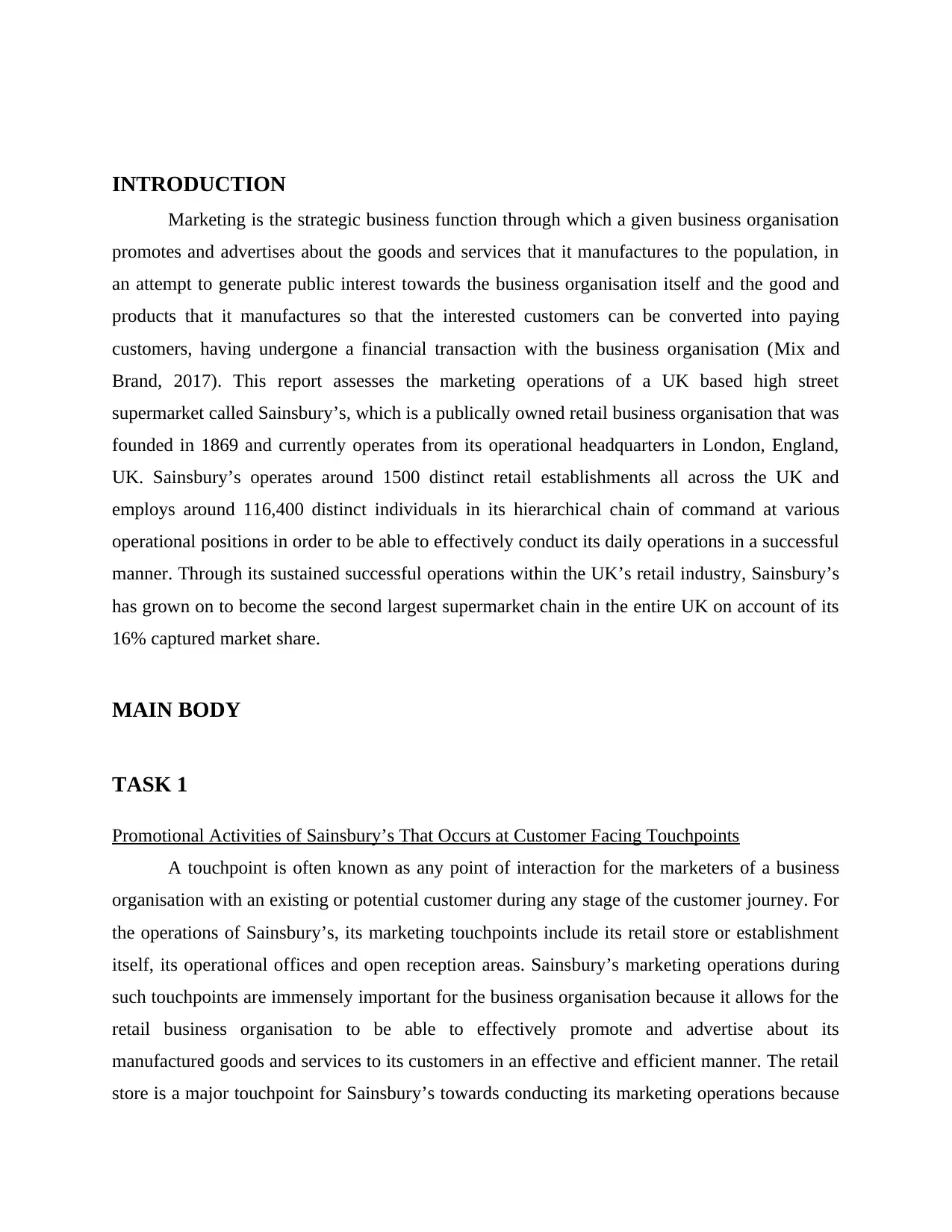
INTRODUCTION
Marketing is the strategic business function through which a given business organisation
promotes and advertises about the goods and services that it manufactures to the population, in
an attempt to generate public interest towards the business organisation itself and the good and
products that it manufactures so that the interested customers can be converted into paying
customers, having undergone a financial transaction with the business organisation (Mix and
Brand, 2017). This report assesses the marketing operations of a UK based high street
supermarket called Sainsbury’s, which is a publically owned retail business organisation that was
founded in 1869 and currently operates from its operational headquarters in London, England,
UK. Sainsbury’s operates around 1500 distinct retail establishments all across the UK and
employs around 116,400 distinct individuals in its hierarchical chain of command at various
operational positions in order to be able to effectively conduct its daily operations in a successful
manner. Through its sustained successful operations within the UK’s retail industry, Sainsbury’s
has grown on to become the second largest supermarket chain in the entire UK on account of its
16% captured market share.
MAIN BODY
TASK 1
Promotional Activities of Sainsbury’s That Occurs at Customer Facing Touchpoints
A touchpoint is often known as any point of interaction for the marketers of a business
organisation with an existing or potential customer during any stage of the customer journey. For
the operations of Sainsbury’s, its marketing touchpoints include its retail store or establishment
itself, its operational offices and open reception areas. Sainsbury’s marketing operations during
such touchpoints are immensely important for the business organisation because it allows for the
retail business organisation to be able to effectively promote and advertise about its
manufactured goods and services to its customers in an effective and efficient manner. The retail
store is a major touchpoint for Sainsbury’s towards conducting its marketing operations because
Marketing is the strategic business function through which a given business organisation
promotes and advertises about the goods and services that it manufactures to the population, in
an attempt to generate public interest towards the business organisation itself and the good and
products that it manufactures so that the interested customers can be converted into paying
customers, having undergone a financial transaction with the business organisation (Mix and
Brand, 2017). This report assesses the marketing operations of a UK based high street
supermarket called Sainsbury’s, which is a publically owned retail business organisation that was
founded in 1869 and currently operates from its operational headquarters in London, England,
UK. Sainsbury’s operates around 1500 distinct retail establishments all across the UK and
employs around 116,400 distinct individuals in its hierarchical chain of command at various
operational positions in order to be able to effectively conduct its daily operations in a successful
manner. Through its sustained successful operations within the UK’s retail industry, Sainsbury’s
has grown on to become the second largest supermarket chain in the entire UK on account of its
16% captured market share.
MAIN BODY
TASK 1
Promotional Activities of Sainsbury’s That Occurs at Customer Facing Touchpoints
A touchpoint is often known as any point of interaction for the marketers of a business
organisation with an existing or potential customer during any stage of the customer journey. For
the operations of Sainsbury’s, its marketing touchpoints include its retail store or establishment
itself, its operational offices and open reception areas. Sainsbury’s marketing operations during
such touchpoints are immensely important for the business organisation because it allows for the
retail business organisation to be able to effectively promote and advertise about its
manufactured goods and services to its customers in an effective and efficient manner. The retail
store is a major touchpoint for Sainsbury’s towards conducting its marketing operations because
⊘ This is a preview!⊘
Do you want full access?
Subscribe today to unlock all pages.

Trusted by 1+ million students worldwide
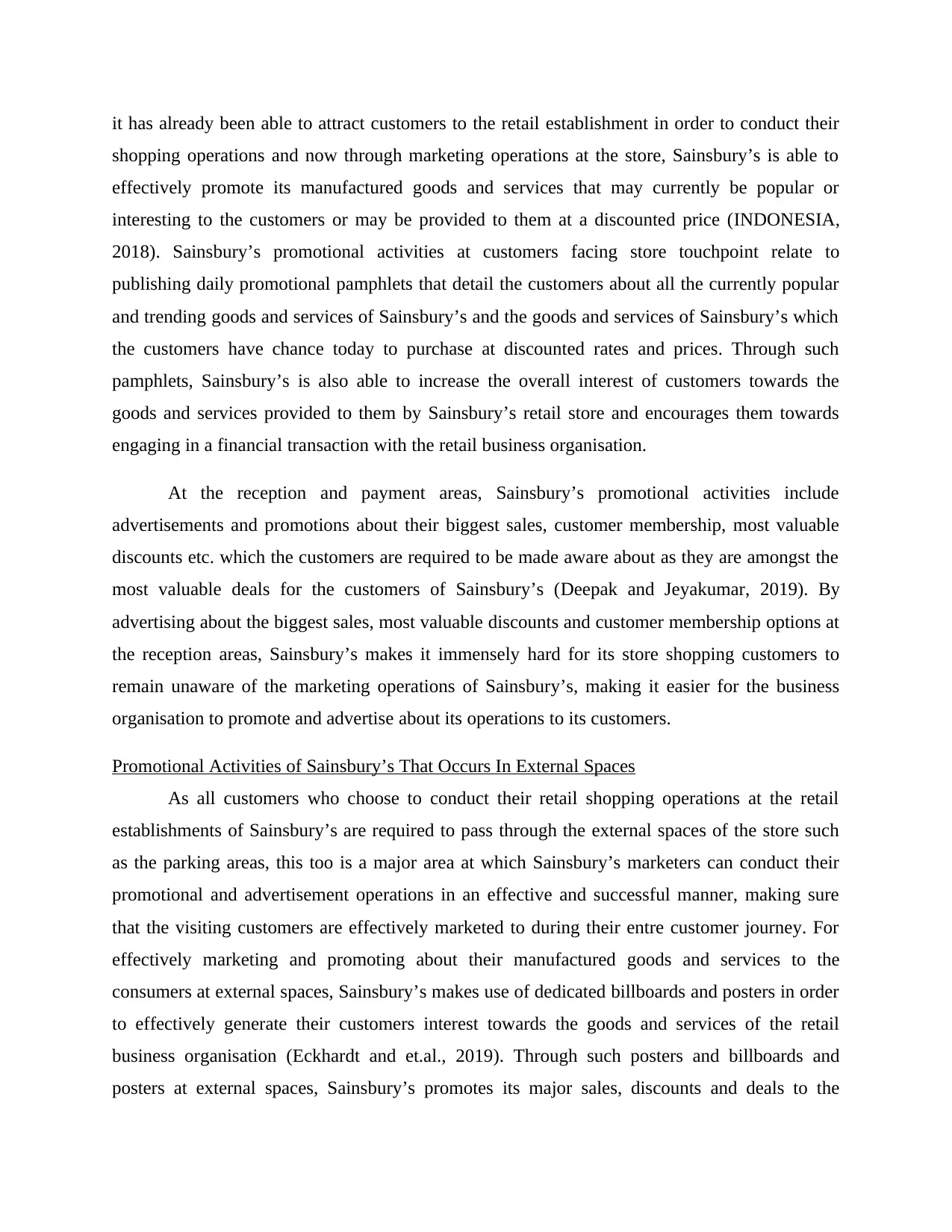
it has already been able to attract customers to the retail establishment in order to conduct their
shopping operations and now through marketing operations at the store, Sainsbury’s is able to
effectively promote its manufactured goods and services that may currently be popular or
interesting to the customers or may be provided to them at a discounted price (INDONESIA,
2018). Sainsbury’s promotional activities at customers facing store touchpoint relate to
publishing daily promotional pamphlets that detail the customers about all the currently popular
and trending goods and services of Sainsbury’s and the goods and services of Sainsbury’s which
the customers have chance today to purchase at discounted rates and prices. Through such
pamphlets, Sainsbury’s is also able to increase the overall interest of customers towards the
goods and services provided to them by Sainsbury’s retail store and encourages them towards
engaging in a financial transaction with the retail business organisation.
At the reception and payment areas, Sainsbury’s promotional activities include
advertisements and promotions about their biggest sales, customer membership, most valuable
discounts etc. which the customers are required to be made aware about as they are amongst the
most valuable deals for the customers of Sainsbury’s (Deepak and Jeyakumar, 2019). By
advertising about the biggest sales, most valuable discounts and customer membership options at
the reception areas, Sainsbury’s makes it immensely hard for its store shopping customers to
remain unaware of the marketing operations of Sainsbury’s, making it easier for the business
organisation to promote and advertise about its operations to its customers.
Promotional Activities of Sainsbury’s That Occurs In External Spaces
As all customers who choose to conduct their retail shopping operations at the retail
establishments of Sainsbury’s are required to pass through the external spaces of the store such
as the parking areas, this too is a major area at which Sainsbury’s marketers can conduct their
promotional and advertisement operations in an effective and successful manner, making sure
that the visiting customers are effectively marketed to during their entre customer journey. For
effectively marketing and promoting about their manufactured goods and services to the
consumers at external spaces, Sainsbury’s makes use of dedicated billboards and posters in order
to effectively generate their customers interest towards the goods and services of the retail
business organisation (Eckhardt and et.al., 2019). Through such posters and billboards and
posters at external spaces, Sainsbury’s promotes its major sales, discounts and deals to the
shopping operations and now through marketing operations at the store, Sainsbury’s is able to
effectively promote its manufactured goods and services that may currently be popular or
interesting to the customers or may be provided to them at a discounted price (INDONESIA,
2018). Sainsbury’s promotional activities at customers facing store touchpoint relate to
publishing daily promotional pamphlets that detail the customers about all the currently popular
and trending goods and services of Sainsbury’s and the goods and services of Sainsbury’s which
the customers have chance today to purchase at discounted rates and prices. Through such
pamphlets, Sainsbury’s is also able to increase the overall interest of customers towards the
goods and services provided to them by Sainsbury’s retail store and encourages them towards
engaging in a financial transaction with the retail business organisation.
At the reception and payment areas, Sainsbury’s promotional activities include
advertisements and promotions about their biggest sales, customer membership, most valuable
discounts etc. which the customers are required to be made aware about as they are amongst the
most valuable deals for the customers of Sainsbury’s (Deepak and Jeyakumar, 2019). By
advertising about the biggest sales, most valuable discounts and customer membership options at
the reception areas, Sainsbury’s makes it immensely hard for its store shopping customers to
remain unaware of the marketing operations of Sainsbury’s, making it easier for the business
organisation to promote and advertise about its operations to its customers.
Promotional Activities of Sainsbury’s That Occurs In External Spaces
As all customers who choose to conduct their retail shopping operations at the retail
establishments of Sainsbury’s are required to pass through the external spaces of the store such
as the parking areas, this too is a major area at which Sainsbury’s marketers can conduct their
promotional and advertisement operations in an effective and successful manner, making sure
that the visiting customers are effectively marketed to during their entre customer journey. For
effectively marketing and promoting about their manufactured goods and services to the
consumers at external spaces, Sainsbury’s makes use of dedicated billboards and posters in order
to effectively generate their customers interest towards the goods and services of the retail
business organisation (Eckhardt and et.al., 2019). Through such posters and billboards and
posters at external spaces, Sainsbury’s promotes its major sales, discounts and deals to the
Paraphrase This Document
Need a fresh take? Get an instant paraphrase of this document with our AI Paraphraser
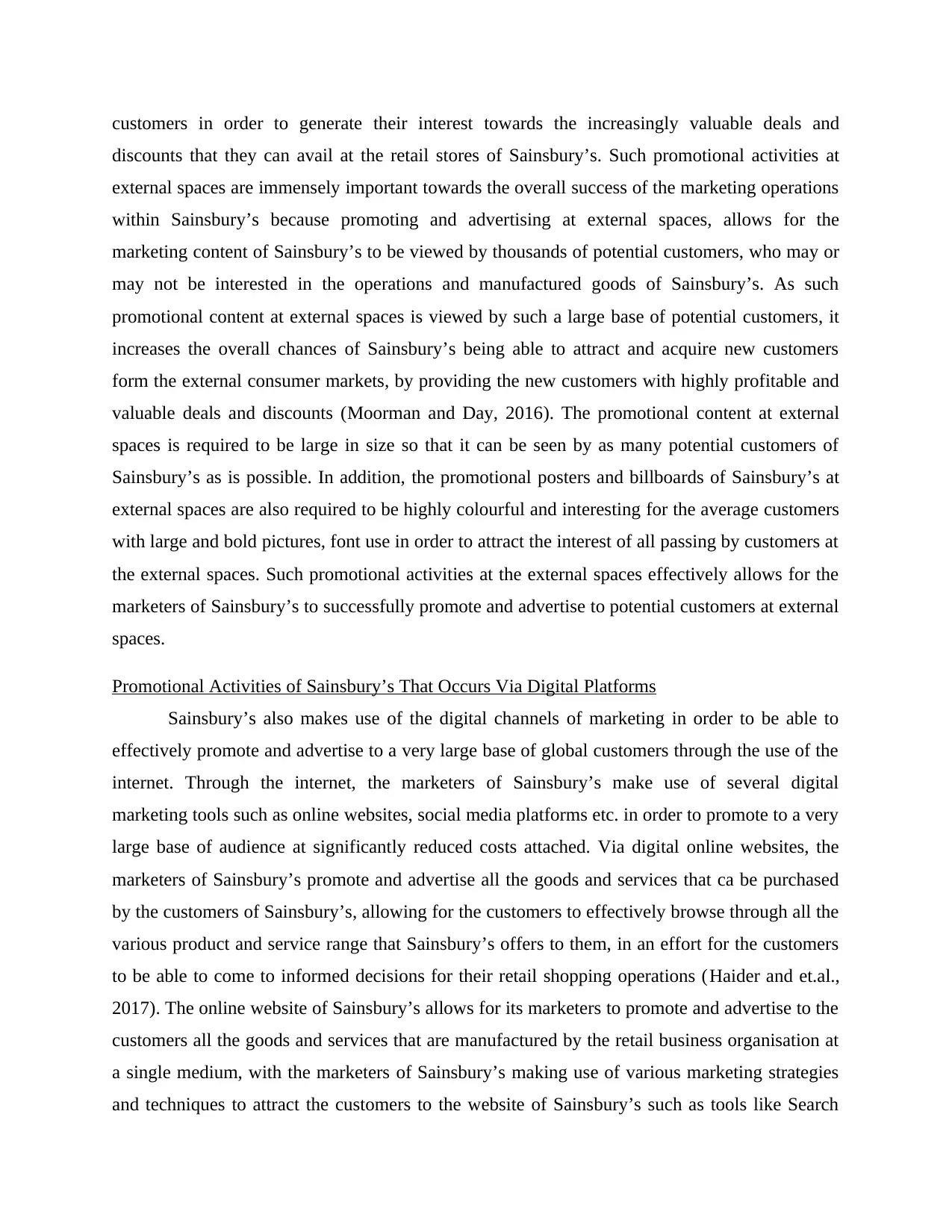
customers in order to generate their interest towards the increasingly valuable deals and
discounts that they can avail at the retail stores of Sainsbury’s. Such promotional activities at
external spaces are immensely important towards the overall success of the marketing operations
within Sainsbury’s because promoting and advertising at external spaces, allows for the
marketing content of Sainsbury’s to be viewed by thousands of potential customers, who may or
may not be interested in the operations and manufactured goods of Sainsbury’s. As such
promotional content at external spaces is viewed by such a large base of potential customers, it
increases the overall chances of Sainsbury’s being able to attract and acquire new customers
form the external consumer markets, by providing the new customers with highly profitable and
valuable deals and discounts (Moorman and Day, 2016). The promotional content at external
spaces is required to be large in size so that it can be seen by as many potential customers of
Sainsbury’s as is possible. In addition, the promotional posters and billboards of Sainsbury’s at
external spaces are also required to be highly colourful and interesting for the average customers
with large and bold pictures, font use in order to attract the interest of all passing by customers at
the external spaces. Such promotional activities at the external spaces effectively allows for the
marketers of Sainsbury’s to successfully promote and advertise to potential customers at external
spaces.
Promotional Activities of Sainsbury’s That Occurs Via Digital Platforms
Sainsbury’s also makes use of the digital channels of marketing in order to be able to
effectively promote and advertise to a very large base of global customers through the use of the
internet. Through the internet, the marketers of Sainsbury’s make use of several digital
marketing tools such as online websites, social media platforms etc. in order to promote to a very
large base of audience at significantly reduced costs attached. Via digital online websites, the
marketers of Sainsbury’s promote and advertise all the goods and services that ca be purchased
by the customers of Sainsbury’s, allowing for the customers to effectively browse through all the
various product and service range that Sainsbury’s offers to them, in an effort for the customers
to be able to come to informed decisions for their retail shopping operations (Haider and et.al.,
2017). The online website of Sainsbury’s allows for its marketers to promote and advertise to the
customers all the goods and services that are manufactured by the retail business organisation at
a single medium, with the marketers of Sainsbury’s making use of various marketing strategies
and techniques to attract the customers to the website of Sainsbury’s such as tools like Search
discounts that they can avail at the retail stores of Sainsbury’s. Such promotional activities at
external spaces are immensely important towards the overall success of the marketing operations
within Sainsbury’s because promoting and advertising at external spaces, allows for the
marketing content of Sainsbury’s to be viewed by thousands of potential customers, who may or
may not be interested in the operations and manufactured goods of Sainsbury’s. As such
promotional content at external spaces is viewed by such a large base of potential customers, it
increases the overall chances of Sainsbury’s being able to attract and acquire new customers
form the external consumer markets, by providing the new customers with highly profitable and
valuable deals and discounts (Moorman and Day, 2016). The promotional content at external
spaces is required to be large in size so that it can be seen by as many potential customers of
Sainsbury’s as is possible. In addition, the promotional posters and billboards of Sainsbury’s at
external spaces are also required to be highly colourful and interesting for the average customers
with large and bold pictures, font use in order to attract the interest of all passing by customers at
the external spaces. Such promotional activities at the external spaces effectively allows for the
marketers of Sainsbury’s to successfully promote and advertise to potential customers at external
spaces.
Promotional Activities of Sainsbury’s That Occurs Via Digital Platforms
Sainsbury’s also makes use of the digital channels of marketing in order to be able to
effectively promote and advertise to a very large base of global customers through the use of the
internet. Through the internet, the marketers of Sainsbury’s make use of several digital
marketing tools such as online websites, social media platforms etc. in order to promote to a very
large base of audience at significantly reduced costs attached. Via digital online websites, the
marketers of Sainsbury’s promote and advertise all the goods and services that ca be purchased
by the customers of Sainsbury’s, allowing for the customers to effectively browse through all the
various product and service range that Sainsbury’s offers to them, in an effort for the customers
to be able to come to informed decisions for their retail shopping operations (Haider and et.al.,
2017). The online website of Sainsbury’s allows for its marketers to promote and advertise to the
customers all the goods and services that are manufactured by the retail business organisation at
a single medium, with the marketers of Sainsbury’s making use of various marketing strategies
and techniques to attract the customers to the website of Sainsbury’s such as tools like Search
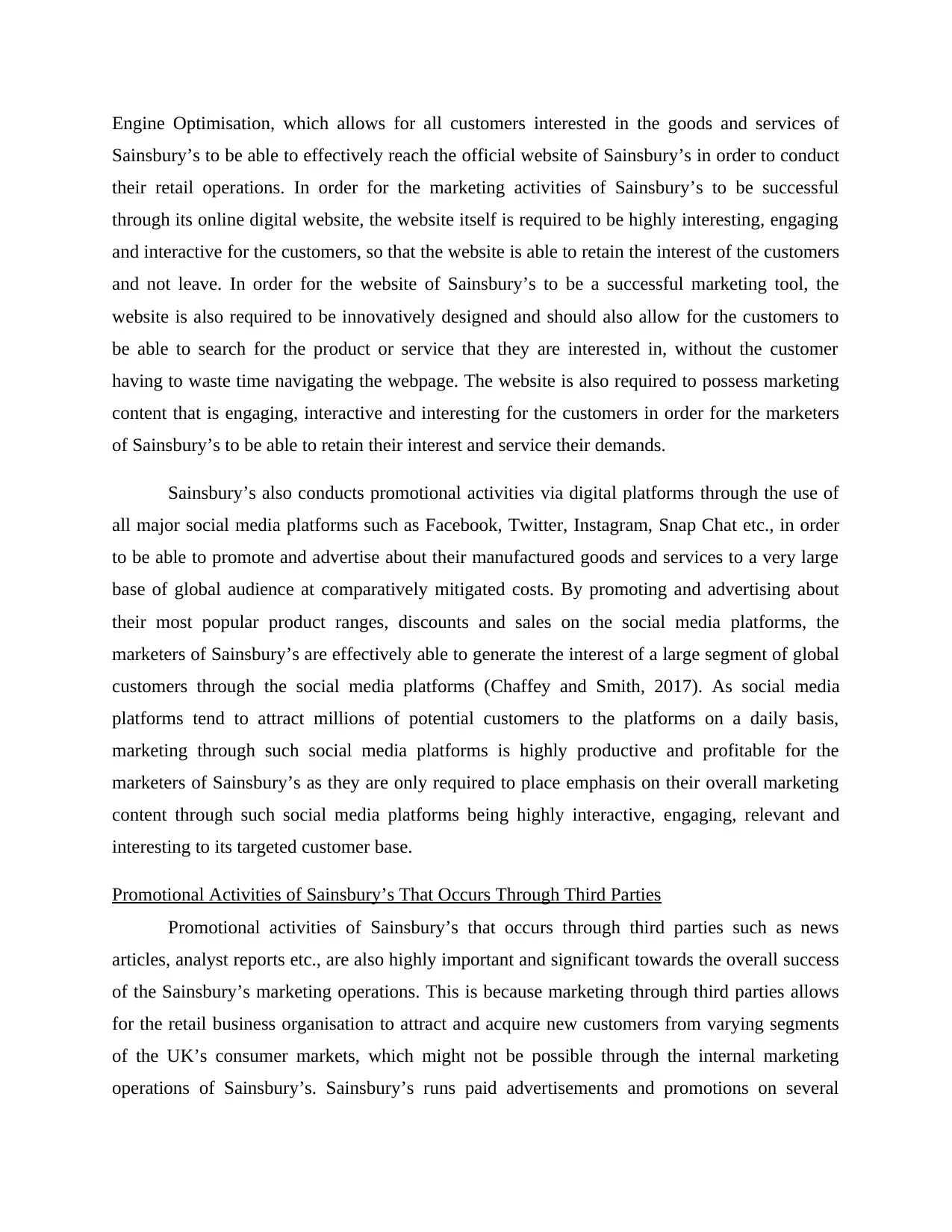
Engine Optimisation, which allows for all customers interested in the goods and services of
Sainsbury’s to be able to effectively reach the official website of Sainsbury’s in order to conduct
their retail operations. In order for the marketing activities of Sainsbury’s to be successful
through its online digital website, the website itself is required to be highly interesting, engaging
and interactive for the customers, so that the website is able to retain the interest of the customers
and not leave. In order for the website of Sainsbury’s to be a successful marketing tool, the
website is also required to be innovatively designed and should also allow for the customers to
be able to search for the product or service that they are interested in, without the customer
having to waste time navigating the webpage. The website is also required to possess marketing
content that is engaging, interactive and interesting for the customers in order for the marketers
of Sainsbury’s to be able to retain their interest and service their demands.
Sainsbury’s also conducts promotional activities via digital platforms through the use of
all major social media platforms such as Facebook, Twitter, Instagram, Snap Chat etc., in order
to be able to promote and advertise about their manufactured goods and services to a very large
base of global audience at comparatively mitigated costs. By promoting and advertising about
their most popular product ranges, discounts and sales on the social media platforms, the
marketers of Sainsbury’s are effectively able to generate the interest of a large segment of global
customers through the social media platforms (Chaffey and Smith, 2017). As social media
platforms tend to attract millions of potential customers to the platforms on a daily basis,
marketing through such social media platforms is highly productive and profitable for the
marketers of Sainsbury’s as they are only required to place emphasis on their overall marketing
content through such social media platforms being highly interactive, engaging, relevant and
interesting to its targeted customer base.
Promotional Activities of Sainsbury’s That Occurs Through Third Parties
Promotional activities of Sainsbury’s that occurs through third parties such as news
articles, analyst reports etc., are also highly important and significant towards the overall success
of the Sainsbury’s marketing operations. This is because marketing through third parties allows
for the retail business organisation to attract and acquire new customers from varying segments
of the UK’s consumer markets, which might not be possible through the internal marketing
operations of Sainsbury’s. Sainsbury’s runs paid advertisements and promotions on several
Sainsbury’s to be able to effectively reach the official website of Sainsbury’s in order to conduct
their retail operations. In order for the marketing activities of Sainsbury’s to be successful
through its online digital website, the website itself is required to be highly interesting, engaging
and interactive for the customers, so that the website is able to retain the interest of the customers
and not leave. In order for the website of Sainsbury’s to be a successful marketing tool, the
website is also required to be innovatively designed and should also allow for the customers to
be able to search for the product or service that they are interested in, without the customer
having to waste time navigating the webpage. The website is also required to possess marketing
content that is engaging, interactive and interesting for the customers in order for the marketers
of Sainsbury’s to be able to retain their interest and service their demands.
Sainsbury’s also conducts promotional activities via digital platforms through the use of
all major social media platforms such as Facebook, Twitter, Instagram, Snap Chat etc., in order
to be able to promote and advertise about their manufactured goods and services to a very large
base of global audience at comparatively mitigated costs. By promoting and advertising about
their most popular product ranges, discounts and sales on the social media platforms, the
marketers of Sainsbury’s are effectively able to generate the interest of a large segment of global
customers through the social media platforms (Chaffey and Smith, 2017). As social media
platforms tend to attract millions of potential customers to the platforms on a daily basis,
marketing through such social media platforms is highly productive and profitable for the
marketers of Sainsbury’s as they are only required to place emphasis on their overall marketing
content through such social media platforms being highly interactive, engaging, relevant and
interesting to its targeted customer base.
Promotional Activities of Sainsbury’s That Occurs Through Third Parties
Promotional activities of Sainsbury’s that occurs through third parties such as news
articles, analyst reports etc., are also highly important and significant towards the overall success
of the Sainsbury’s marketing operations. This is because marketing through third parties allows
for the retail business organisation to attract and acquire new customers from varying segments
of the UK’s consumer markets, which might not be possible through the internal marketing
operations of Sainsbury’s. Sainsbury’s runs paid advertisements and promotions on several
⊘ This is a preview!⊘
Do you want full access?
Subscribe today to unlock all pages.

Trusted by 1+ million students worldwide
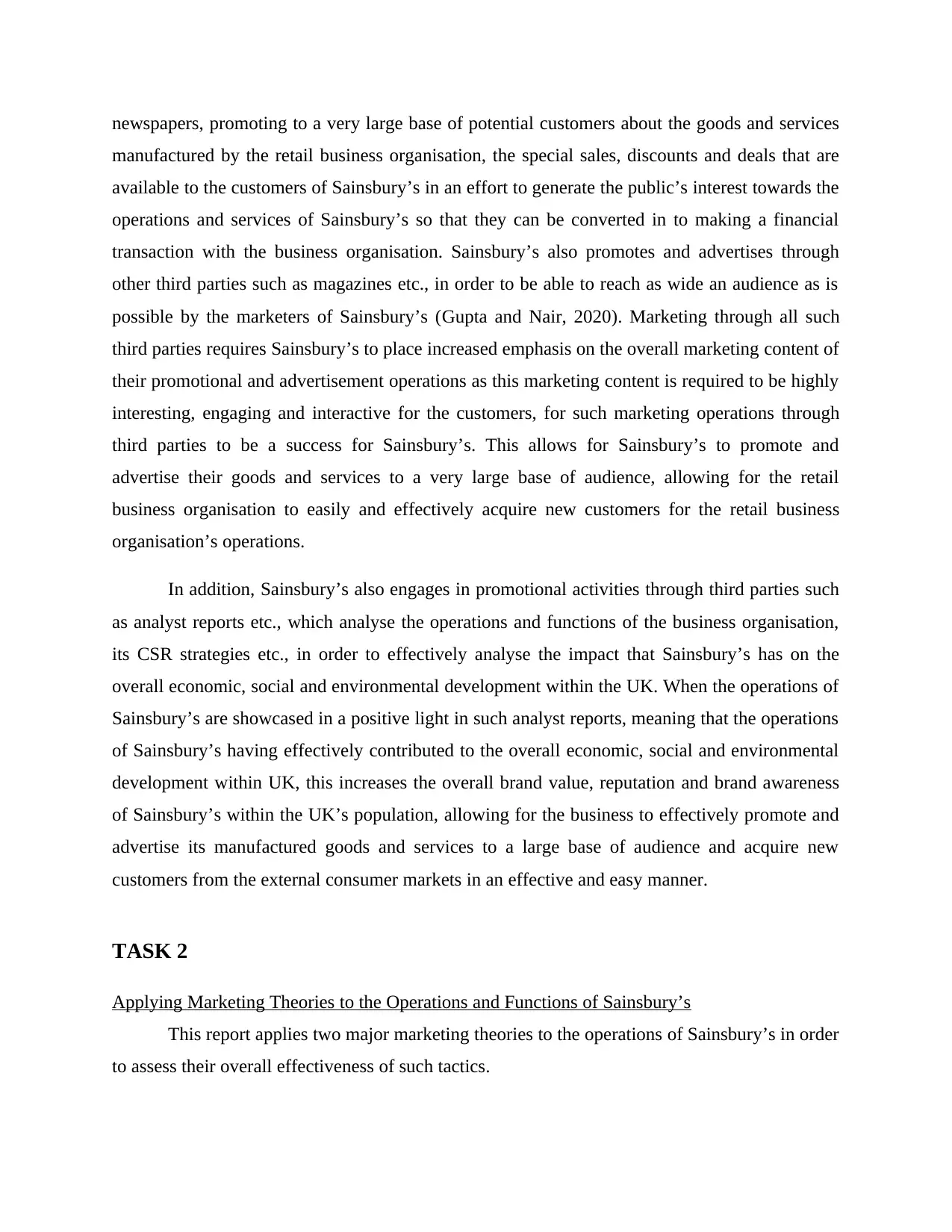
newspapers, promoting to a very large base of potential customers about the goods and services
manufactured by the retail business organisation, the special sales, discounts and deals that are
available to the customers of Sainsbury’s in an effort to generate the public’s interest towards the
operations and services of Sainsbury’s so that they can be converted in to making a financial
transaction with the business organisation. Sainsbury’s also promotes and advertises through
other third parties such as magazines etc., in order to be able to reach as wide an audience as is
possible by the marketers of Sainsbury’s (Gupta and Nair, 2020). Marketing through all such
third parties requires Sainsbury’s to place increased emphasis on the overall marketing content of
their promotional and advertisement operations as this marketing content is required to be highly
interesting, engaging and interactive for the customers, for such marketing operations through
third parties to be a success for Sainsbury’s. This allows for Sainsbury’s to promote and
advertise their goods and services to a very large base of audience, allowing for the retail
business organisation to easily and effectively acquire new customers for the retail business
organisation’s operations.
In addition, Sainsbury’s also engages in promotional activities through third parties such
as analyst reports etc., which analyse the operations and functions of the business organisation,
its CSR strategies etc., in order to effectively analyse the impact that Sainsbury’s has on the
overall economic, social and environmental development within the UK. When the operations of
Sainsbury’s are showcased in a positive light in such analyst reports, meaning that the operations
of Sainsbury’s having effectively contributed to the overall economic, social and environmental
development within UK, this increases the overall brand value, reputation and brand awareness
of Sainsbury’s within the UK’s population, allowing for the business to effectively promote and
advertise its manufactured goods and services to a large base of audience and acquire new
customers from the external consumer markets in an effective and easy manner.
TASK 2
Applying Marketing Theories to the Operations and Functions of Sainsbury’s
This report applies two major marketing theories to the operations of Sainsbury’s in order
to assess their overall effectiveness of such tactics.
manufactured by the retail business organisation, the special sales, discounts and deals that are
available to the customers of Sainsbury’s in an effort to generate the public’s interest towards the
operations and services of Sainsbury’s so that they can be converted in to making a financial
transaction with the business organisation. Sainsbury’s also promotes and advertises through
other third parties such as magazines etc., in order to be able to reach as wide an audience as is
possible by the marketers of Sainsbury’s (Gupta and Nair, 2020). Marketing through all such
third parties requires Sainsbury’s to place increased emphasis on the overall marketing content of
their promotional and advertisement operations as this marketing content is required to be highly
interesting, engaging and interactive for the customers, for such marketing operations through
third parties to be a success for Sainsbury’s. This allows for Sainsbury’s to promote and
advertise their goods and services to a very large base of audience, allowing for the retail
business organisation to easily and effectively acquire new customers for the retail business
organisation’s operations.
In addition, Sainsbury’s also engages in promotional activities through third parties such
as analyst reports etc., which analyse the operations and functions of the business organisation,
its CSR strategies etc., in order to effectively analyse the impact that Sainsbury’s has on the
overall economic, social and environmental development within the UK. When the operations of
Sainsbury’s are showcased in a positive light in such analyst reports, meaning that the operations
of Sainsbury’s having effectively contributed to the overall economic, social and environmental
development within UK, this increases the overall brand value, reputation and brand awareness
of Sainsbury’s within the UK’s population, allowing for the business to effectively promote and
advertise its manufactured goods and services to a large base of audience and acquire new
customers from the external consumer markets in an effective and easy manner.
TASK 2
Applying Marketing Theories to the Operations and Functions of Sainsbury’s
This report applies two major marketing theories to the operations of Sainsbury’s in order
to assess their overall effectiveness of such tactics.
Paraphrase This Document
Need a fresh take? Get an instant paraphrase of this document with our AI Paraphraser
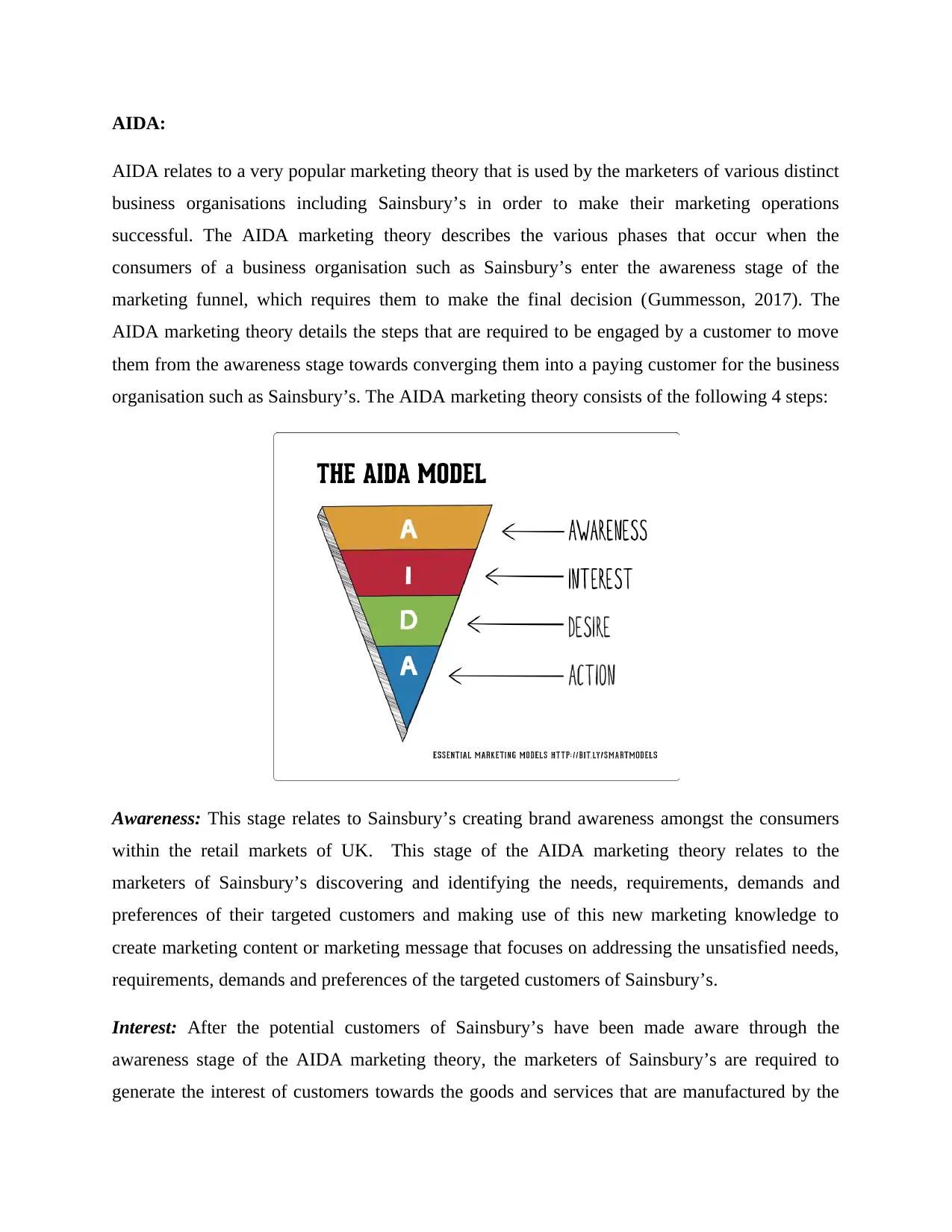
AIDA:
AIDA relates to a very popular marketing theory that is used by the marketers of various distinct
business organisations including Sainsbury’s in order to make their marketing operations
successful. The AIDA marketing theory describes the various phases that occur when the
consumers of a business organisation such as Sainsbury’s enter the awareness stage of the
marketing funnel, which requires them to make the final decision (Gummesson, 2017). The
AIDA marketing theory details the steps that are required to be engaged by a customer to move
them from the awareness stage towards converging them into a paying customer for the business
organisation such as Sainsbury’s. The AIDA marketing theory consists of the following 4 steps:
Awareness: This stage relates to Sainsbury’s creating brand awareness amongst the consumers
within the retail markets of UK. This stage of the AIDA marketing theory relates to the
marketers of Sainsbury’s discovering and identifying the needs, requirements, demands and
preferences of their targeted customers and making use of this new marketing knowledge to
create marketing content or marketing message that focuses on addressing the unsatisfied needs,
requirements, demands and preferences of the targeted customers of Sainsbury’s.
Interest: After the potential customers of Sainsbury’s have been made aware through the
awareness stage of the AIDA marketing theory, the marketers of Sainsbury’s are required to
generate the interest of customers towards the goods and services that are manufactured by the
AIDA relates to a very popular marketing theory that is used by the marketers of various distinct
business organisations including Sainsbury’s in order to make their marketing operations
successful. The AIDA marketing theory describes the various phases that occur when the
consumers of a business organisation such as Sainsbury’s enter the awareness stage of the
marketing funnel, which requires them to make the final decision (Gummesson, 2017). The
AIDA marketing theory details the steps that are required to be engaged by a customer to move
them from the awareness stage towards converging them into a paying customer for the business
organisation such as Sainsbury’s. The AIDA marketing theory consists of the following 4 steps:
Awareness: This stage relates to Sainsbury’s creating brand awareness amongst the consumers
within the retail markets of UK. This stage of the AIDA marketing theory relates to the
marketers of Sainsbury’s discovering and identifying the needs, requirements, demands and
preferences of their targeted customers and making use of this new marketing knowledge to
create marketing content or marketing message that focuses on addressing the unsatisfied needs,
requirements, demands and preferences of the targeted customers of Sainsbury’s.
Interest: After the potential customers of Sainsbury’s have been made aware through the
awareness stage of the AIDA marketing theory, the marketers of Sainsbury’s are required to
generate the interest of customers towards the goods and services that are manufactured by the
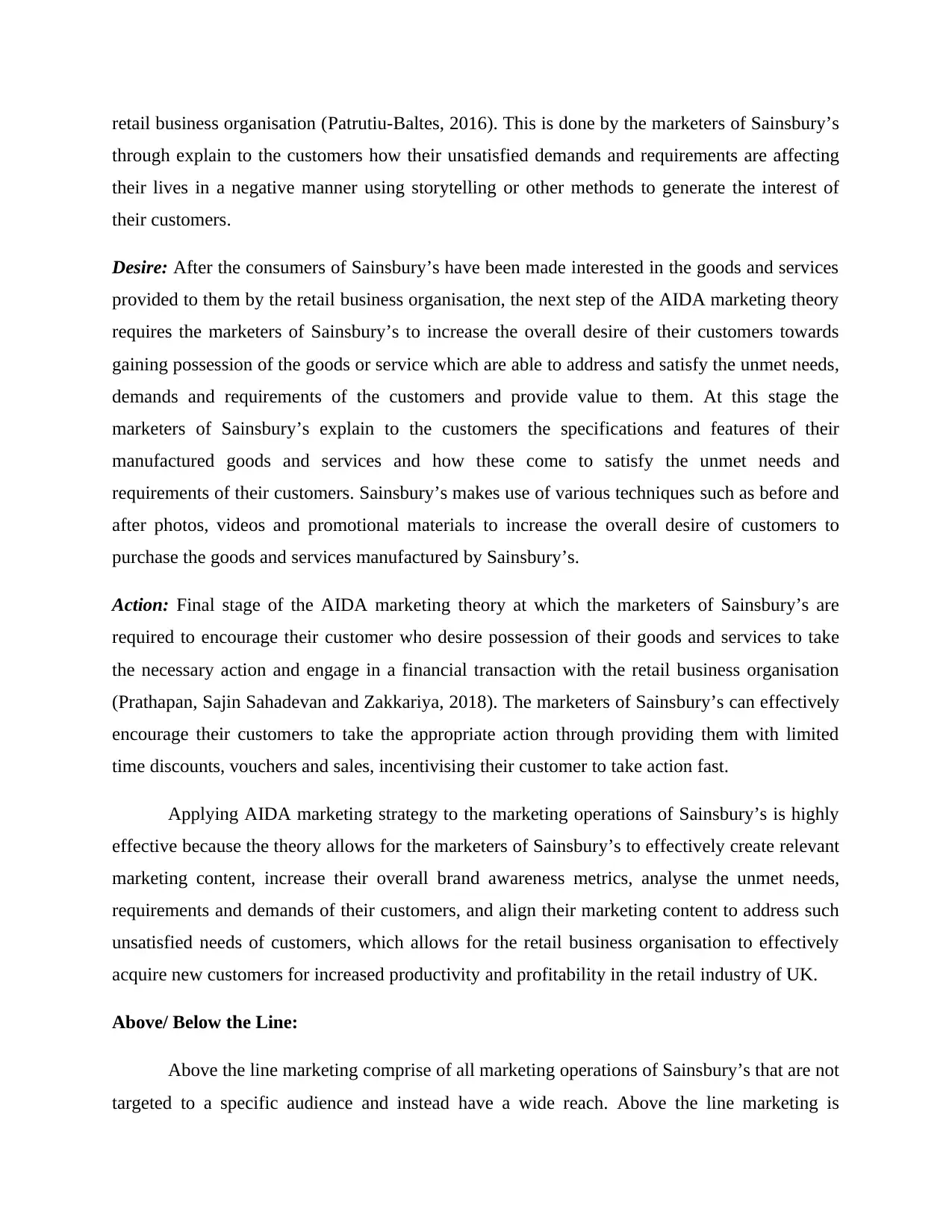
retail business organisation (Patrutiu-Baltes, 2016). This is done by the marketers of Sainsbury’s
through explain to the customers how their unsatisfied demands and requirements are affecting
their lives in a negative manner using storytelling or other methods to generate the interest of
their customers.
Desire: After the consumers of Sainsbury’s have been made interested in the goods and services
provided to them by the retail business organisation, the next step of the AIDA marketing theory
requires the marketers of Sainsbury’s to increase the overall desire of their customers towards
gaining possession of the goods or service which are able to address and satisfy the unmet needs,
demands and requirements of the customers and provide value to them. At this stage the
marketers of Sainsbury’s explain to the customers the specifications and features of their
manufactured goods and services and how these come to satisfy the unmet needs and
requirements of their customers. Sainsbury’s makes use of various techniques such as before and
after photos, videos and promotional materials to increase the overall desire of customers to
purchase the goods and services manufactured by Sainsbury’s.
Action: Final stage of the AIDA marketing theory at which the marketers of Sainsbury’s are
required to encourage their customer who desire possession of their goods and services to take
the necessary action and engage in a financial transaction with the retail business organisation
(Prathapan, Sajin Sahadevan and Zakkariya, 2018). The marketers of Sainsbury’s can effectively
encourage their customers to take the appropriate action through providing them with limited
time discounts, vouchers and sales, incentivising their customer to take action fast.
Applying AIDA marketing strategy to the marketing operations of Sainsbury’s is highly
effective because the theory allows for the marketers of Sainsbury’s to effectively create relevant
marketing content, increase their overall brand awareness metrics, analyse the unmet needs,
requirements and demands of their customers, and align their marketing content to address such
unsatisfied needs of customers, which allows for the retail business organisation to effectively
acquire new customers for increased productivity and profitability in the retail industry of UK.
Above/ Below the Line:
Above the line marketing comprise of all marketing operations of Sainsbury’s that are not
targeted to a specific audience and instead have a wide reach. Above the line marketing is
through explain to the customers how their unsatisfied demands and requirements are affecting
their lives in a negative manner using storytelling or other methods to generate the interest of
their customers.
Desire: After the consumers of Sainsbury’s have been made interested in the goods and services
provided to them by the retail business organisation, the next step of the AIDA marketing theory
requires the marketers of Sainsbury’s to increase the overall desire of their customers towards
gaining possession of the goods or service which are able to address and satisfy the unmet needs,
demands and requirements of the customers and provide value to them. At this stage the
marketers of Sainsbury’s explain to the customers the specifications and features of their
manufactured goods and services and how these come to satisfy the unmet needs and
requirements of their customers. Sainsbury’s makes use of various techniques such as before and
after photos, videos and promotional materials to increase the overall desire of customers to
purchase the goods and services manufactured by Sainsbury’s.
Action: Final stage of the AIDA marketing theory at which the marketers of Sainsbury’s are
required to encourage their customer who desire possession of their goods and services to take
the necessary action and engage in a financial transaction with the retail business organisation
(Prathapan, Sajin Sahadevan and Zakkariya, 2018). The marketers of Sainsbury’s can effectively
encourage their customers to take the appropriate action through providing them with limited
time discounts, vouchers and sales, incentivising their customer to take action fast.
Applying AIDA marketing strategy to the marketing operations of Sainsbury’s is highly
effective because the theory allows for the marketers of Sainsbury’s to effectively create relevant
marketing content, increase their overall brand awareness metrics, analyse the unmet needs,
requirements and demands of their customers, and align their marketing content to address such
unsatisfied needs of customers, which allows for the retail business organisation to effectively
acquire new customers for increased productivity and profitability in the retail industry of UK.
Above/ Below the Line:
Above the line marketing comprise of all marketing operations of Sainsbury’s that are not
targeted to a specific audience and instead have a wide reach. Above the line marketing is
⊘ This is a preview!⊘
Do you want full access?
Subscribe today to unlock all pages.

Trusted by 1+ million students worldwide
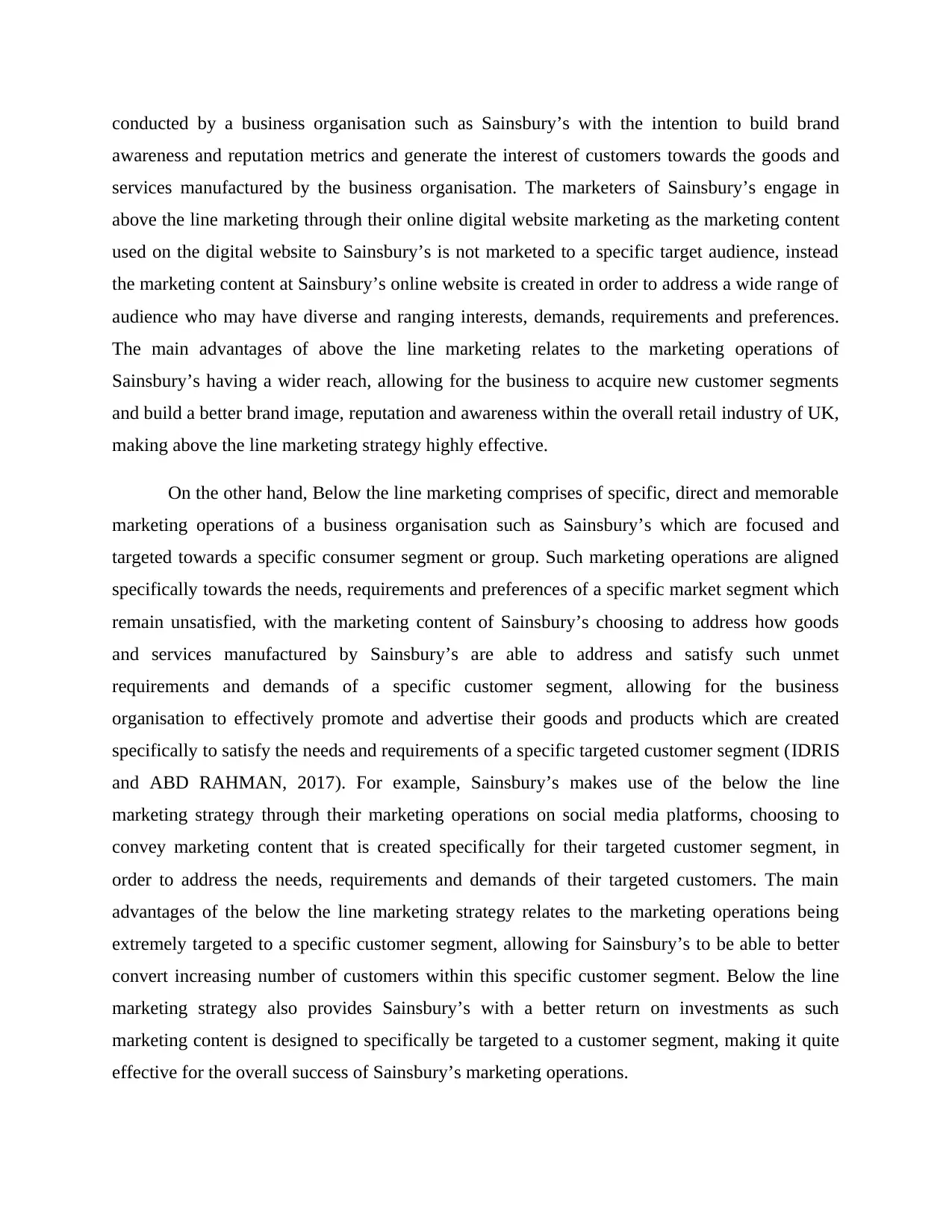
conducted by a business organisation such as Sainsbury’s with the intention to build brand
awareness and reputation metrics and generate the interest of customers towards the goods and
services manufactured by the business organisation. The marketers of Sainsbury’s engage in
above the line marketing through their online digital website marketing as the marketing content
used on the digital website to Sainsbury’s is not marketed to a specific target audience, instead
the marketing content at Sainsbury’s online website is created in order to address a wide range of
audience who may have diverse and ranging interests, demands, requirements and preferences.
The main advantages of above the line marketing relates to the marketing operations of
Sainsbury’s having a wider reach, allowing for the business to acquire new customer segments
and build a better brand image, reputation and awareness within the overall retail industry of UK,
making above the line marketing strategy highly effective.
On the other hand, Below the line marketing comprises of specific, direct and memorable
marketing operations of a business organisation such as Sainsbury’s which are focused and
targeted towards a specific consumer segment or group. Such marketing operations are aligned
specifically towards the needs, requirements and preferences of a specific market segment which
remain unsatisfied, with the marketing content of Sainsbury’s choosing to address how goods
and services manufactured by Sainsbury’s are able to address and satisfy such unmet
requirements and demands of a specific customer segment, allowing for the business
organisation to effectively promote and advertise their goods and products which are created
specifically to satisfy the needs and requirements of a specific targeted customer segment (IDRIS
and ABD RAHMAN, 2017). For example, Sainsbury’s makes use of the below the line
marketing strategy through their marketing operations on social media platforms, choosing to
convey marketing content that is created specifically for their targeted customer segment, in
order to address the needs, requirements and demands of their targeted customers. The main
advantages of the below the line marketing strategy relates to the marketing operations being
extremely targeted to a specific customer segment, allowing for Sainsbury’s to be able to better
convert increasing number of customers within this specific customer segment. Below the line
marketing strategy also provides Sainsbury’s with a better return on investments as such
marketing content is designed to specifically be targeted to a customer segment, making it quite
effective for the overall success of Sainsbury’s marketing operations.
awareness and reputation metrics and generate the interest of customers towards the goods and
services manufactured by the business organisation. The marketers of Sainsbury’s engage in
above the line marketing through their online digital website marketing as the marketing content
used on the digital website to Sainsbury’s is not marketed to a specific target audience, instead
the marketing content at Sainsbury’s online website is created in order to address a wide range of
audience who may have diverse and ranging interests, demands, requirements and preferences.
The main advantages of above the line marketing relates to the marketing operations of
Sainsbury’s having a wider reach, allowing for the business to acquire new customer segments
and build a better brand image, reputation and awareness within the overall retail industry of UK,
making above the line marketing strategy highly effective.
On the other hand, Below the line marketing comprises of specific, direct and memorable
marketing operations of a business organisation such as Sainsbury’s which are focused and
targeted towards a specific consumer segment or group. Such marketing operations are aligned
specifically towards the needs, requirements and preferences of a specific market segment which
remain unsatisfied, with the marketing content of Sainsbury’s choosing to address how goods
and services manufactured by Sainsbury’s are able to address and satisfy such unmet
requirements and demands of a specific customer segment, allowing for the business
organisation to effectively promote and advertise their goods and products which are created
specifically to satisfy the needs and requirements of a specific targeted customer segment (IDRIS
and ABD RAHMAN, 2017). For example, Sainsbury’s makes use of the below the line
marketing strategy through their marketing operations on social media platforms, choosing to
convey marketing content that is created specifically for their targeted customer segment, in
order to address the needs, requirements and demands of their targeted customers. The main
advantages of the below the line marketing strategy relates to the marketing operations being
extremely targeted to a specific customer segment, allowing for Sainsbury’s to be able to better
convert increasing number of customers within this specific customer segment. Below the line
marketing strategy also provides Sainsbury’s with a better return on investments as such
marketing content is designed to specifically be targeted to a customer segment, making it quite
effective for the overall success of Sainsbury’s marketing operations.
Paraphrase This Document
Need a fresh take? Get an instant paraphrase of this document with our AI Paraphraser
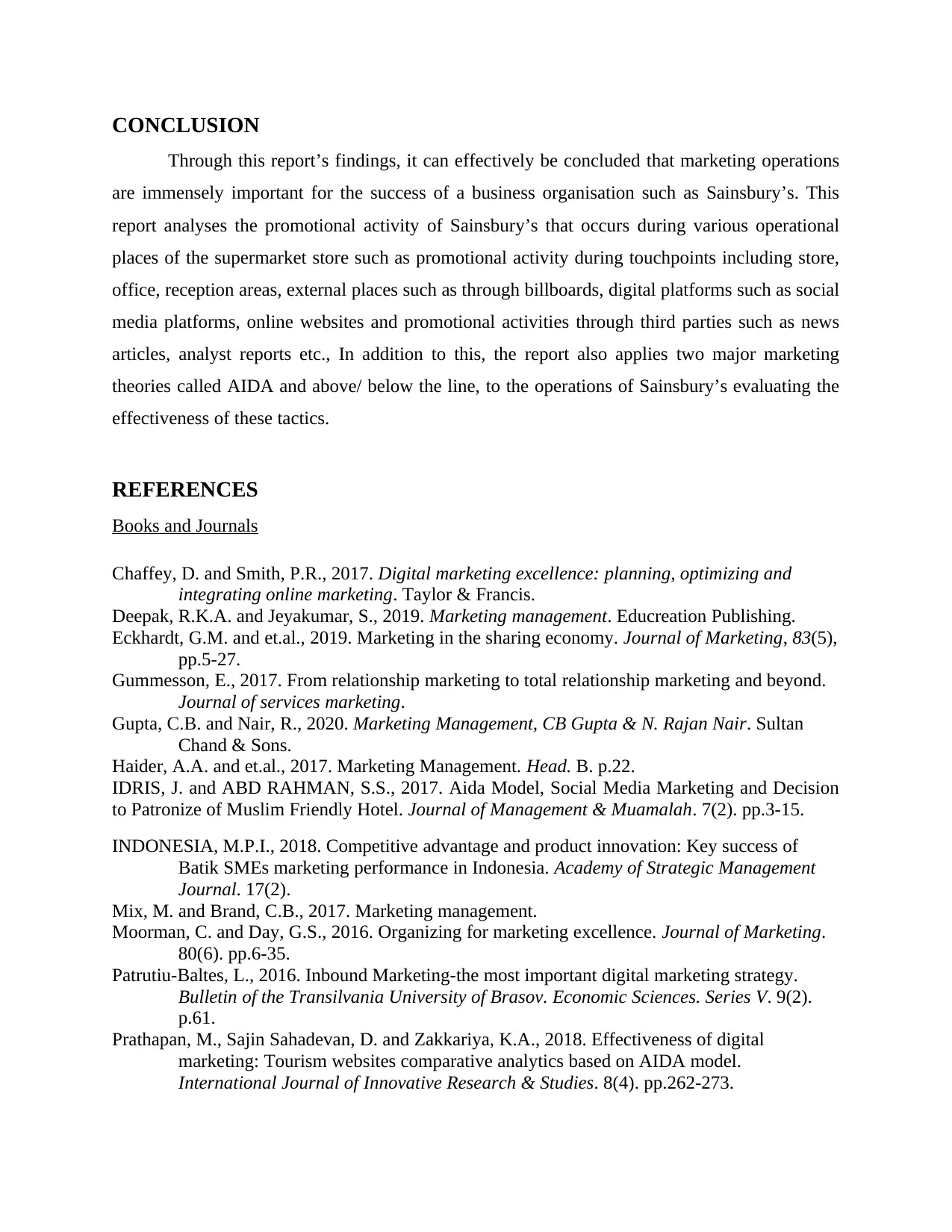
CONCLUSION
Through this report’s findings, it can effectively be concluded that marketing operations
are immensely important for the success of a business organisation such as Sainsbury’s. This
report analyses the promotional activity of Sainsbury’s that occurs during various operational
places of the supermarket store such as promotional activity during touchpoints including store,
office, reception areas, external places such as through billboards, digital platforms such as social
media platforms, online websites and promotional activities through third parties such as news
articles, analyst reports etc., In addition to this, the report also applies two major marketing
theories called AIDA and above/ below the line, to the operations of Sainsbury’s evaluating the
effectiveness of these tactics.
REFERENCES
Books and Journals
Chaffey, D. and Smith, P.R., 2017. Digital marketing excellence: planning, optimizing and
integrating online marketing. Taylor & Francis.
Deepak, R.K.A. and Jeyakumar, S., 2019. Marketing management. Educreation Publishing.
Eckhardt, G.M. and et.al., 2019. Marketing in the sharing economy. Journal of Marketing, 83(5),
pp.5-27.
Gummesson, E., 2017. From relationship marketing to total relationship marketing and beyond.
Journal of services marketing.
Gupta, C.B. and Nair, R., 2020. Marketing Management, CB Gupta & N. Rajan Nair. Sultan
Chand & Sons.
Haider, A.A. and et.al., 2017. Marketing Management. Head. B. p.22.
IDRIS, J. and ABD RAHMAN, S.S., 2017. Aida Model, Social Media Marketing and Decision
to Patronize of Muslim Friendly Hotel. Journal of Management & Muamalah. 7(2). pp.3-15.
INDONESIA, M.P.I., 2018. Competitive advantage and product innovation: Key success of
Batik SMEs marketing performance in Indonesia. Academy of Strategic Management
Journal. 17(2).
Mix, M. and Brand, C.B., 2017. Marketing management.
Moorman, C. and Day, G.S., 2016. Organizing for marketing excellence. Journal of Marketing.
80(6). pp.6-35.
Patrutiu-Baltes, L., 2016. Inbound Marketing-the most important digital marketing strategy.
Bulletin of the Transilvania University of Brasov. Economic Sciences. Series V. 9(2).
p.61.
Prathapan, M., Sajin Sahadevan, D. and Zakkariya, K.A., 2018. Effectiveness of digital
marketing: Tourism websites comparative analytics based on AIDA model.
International Journal of Innovative Research & Studies. 8(4). pp.262-273.
Through this report’s findings, it can effectively be concluded that marketing operations
are immensely important for the success of a business organisation such as Sainsbury’s. This
report analyses the promotional activity of Sainsbury’s that occurs during various operational
places of the supermarket store such as promotional activity during touchpoints including store,
office, reception areas, external places such as through billboards, digital platforms such as social
media platforms, online websites and promotional activities through third parties such as news
articles, analyst reports etc., In addition to this, the report also applies two major marketing
theories called AIDA and above/ below the line, to the operations of Sainsbury’s evaluating the
effectiveness of these tactics.
REFERENCES
Books and Journals
Chaffey, D. and Smith, P.R., 2017. Digital marketing excellence: planning, optimizing and
integrating online marketing. Taylor & Francis.
Deepak, R.K.A. and Jeyakumar, S., 2019. Marketing management. Educreation Publishing.
Eckhardt, G.M. and et.al., 2019. Marketing in the sharing economy. Journal of Marketing, 83(5),
pp.5-27.
Gummesson, E., 2017. From relationship marketing to total relationship marketing and beyond.
Journal of services marketing.
Gupta, C.B. and Nair, R., 2020. Marketing Management, CB Gupta & N. Rajan Nair. Sultan
Chand & Sons.
Haider, A.A. and et.al., 2017. Marketing Management. Head. B. p.22.
IDRIS, J. and ABD RAHMAN, S.S., 2017. Aida Model, Social Media Marketing and Decision
to Patronize of Muslim Friendly Hotel. Journal of Management & Muamalah. 7(2). pp.3-15.
INDONESIA, M.P.I., 2018. Competitive advantage and product innovation: Key success of
Batik SMEs marketing performance in Indonesia. Academy of Strategic Management
Journal. 17(2).
Mix, M. and Brand, C.B., 2017. Marketing management.
Moorman, C. and Day, G.S., 2016. Organizing for marketing excellence. Journal of Marketing.
80(6). pp.6-35.
Patrutiu-Baltes, L., 2016. Inbound Marketing-the most important digital marketing strategy.
Bulletin of the Transilvania University of Brasov. Economic Sciences. Series V. 9(2).
p.61.
Prathapan, M., Sajin Sahadevan, D. and Zakkariya, K.A., 2018. Effectiveness of digital
marketing: Tourism websites comparative analytics based on AIDA model.
International Journal of Innovative Research & Studies. 8(4). pp.262-273.
1 out of 11
Related Documents
Your All-in-One AI-Powered Toolkit for Academic Success.
+13062052269
info@desklib.com
Available 24*7 on WhatsApp / Email
![[object Object]](/_next/static/media/star-bottom.7253800d.svg)
Unlock your academic potential
Copyright © 2020–2025 A2Z Services. All Rights Reserved. Developed and managed by ZUCOL.





